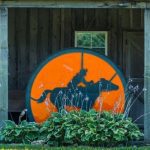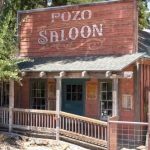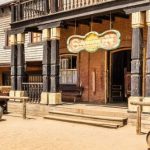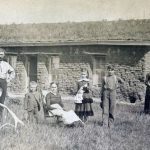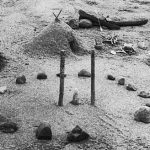 Music
Music  Music
Music  Space
Space 10 Asteroids That Sneaked Closer Than Our Satellites
 Sport
Sport The 10 Least Credible Superstars in Professional Sports
 Animals
Animals 10 Strange Times When Species Evolved Backward
 Facts
Facts Ten Unexpectedly Fascinating Facts About Rain
 Crime
Crime 10 Dark Details of Australia’s Gruesome Unsolved Wanda Murders
 Humans
Humans 10 Unsung Figures Behind Some of History’s Most Famous Journeys
 Animals
Animals 10 Species That Refused to Go Extinct
 Weird Stuff
Weird Stuff 10 Weird Things People Used to Do at New Year’s
 Our World
Our World 10 Archaeological Discoveries of 2025 That Refined History
 Music
Music 10 Chance Encounters That Formed Legendary Bands
 Space
Space 10 Asteroids That Sneaked Closer Than Our Satellites
 Sport
Sport The 10 Least Credible Superstars in Professional Sports
Who's Behind Listverse?

Jamie Frater
Head Editor
Jamie founded Listverse due to an insatiable desire to share fascinating, obscure, and bizarre facts. He has been a guest speaker on numerous national radio and television stations and is a five time published author.
More About Us Animals
Animals 10 Strange Times When Species Evolved Backward
 Facts
Facts Ten Unexpectedly Fascinating Facts About Rain
 Crime
Crime 10 Dark Details of Australia’s Gruesome Unsolved Wanda Murders
 Humans
Humans 10 Unsung Figures Behind Some of History’s Most Famous Journeys
 Animals
Animals 10 Species That Refused to Go Extinct
 Weird Stuff
Weird Stuff 10 Weird Things People Used to Do at New Year’s
 Our World
Our World 10 Archaeological Discoveries of 2025 That Refined History
Ten Revealing Facts about Daily Domestic Life in the Old West
The Wild West was a wild place. That appropriate moniker was based on the adventure and boldness required to trek across the land. Pioneers encountered danger at every turn, and the barren prairie was unforgiving. Healthcare was non-existent. Language and cultural differences with native inhabitants added to the uncertainty. And it wasn’t just the Western-worthy adventure stories that brought trouble.
In fact, everyday life in the Old West was brutal, too. Wells and water pumps were nearly non-existent throughout the Great Plains and Mountain West in the 19th century. Of course, only America’s largest East Coast cities had indoor plumbing then. So it wasn’t like the people back home were living much better. But domestic life in the Wild West required inventiveness and persistence beyond measure.
Pioneer families who struck out across the Plains had to battle every day just to complete simple hygienic tasks. Granted, their knowledge base was nothing like what we have today. Thankfully, by the end of the 19th century, information about domestic life was more readily available to pioneers. But the spread of this know-how was slow and inconsistent. Before that, hygiene habits and home-bound happenings completely differed from what we know today. These ten facts about domestic life in the Old West will shock you!
Related: Top 10 Weird Sexual Things The Ancient Greeks Did
10 Sketchy Houses Meant Unwanted Houseguests
Across the prairie, sod houses were built quickly and imperfectly to shelter people moving westward. The construction was questionable, and the buildings were far from air-tight. Left unsealed from the elements—and constructed directly from the dirt—these houses were havens for all kinds of creatures.
Most of the homes had dirt floors, leaky roofs, and plenty of critter roommates. Families suffered with endless bugs and all-too-common snakes as houseguests. The dust was so brutal that mothers would pour greasy dishwater on the floor to tamp it down. The unsanitary water attracted even more insects, creating an awful cycle. Roof leaks were common and often severe. The sod couldn’t hold up against severe weather, and it often crumbled.
Homesteaders routinely told tales of leaky ceilings, soaked bed sheets, and soiled clothes. Because there was no running water in most frontier settlements, hygiene was horrific. Pioneers were forced to haul large buckets of water from nearby streams and creeks into their homes. They boiled the water to scalding temperatures to avoid the few germs they knew about. Then, they tried to clean dishes (and themselves) with unforgiving homemade lye soaps. The result was hell on the skin. Worse, the inconsistent application made for a bacteria paradise. Today’s germaphobes would be right to wonder how anyone survived it at all![1]
9 Guessing and Experimenting with Germ Concerns
Today, we take germ science for granted. It seems like common sense to clean one’s hands, disinfect surfaces, and wash dishes and utensils after use. But back in the 19th century, germ theory was in its infancy. Back east, Ivy League scientists were doing groundbreaking work on the spread of disease. Their research on viruses would radically change the world forever.
Household cleaners weren’t on the scene yet, either. Lysol was invented in 1889 and popularly marketed a few years after that. By then, the pioneers had mostly settled. Out West, it would be some time before any germ or disinfectant knowledge could help. Supplies were very limited, so families made do with what they had. They would all share the same cup and eat from the same plate. In saloons, countless patrons would share a single bar towel to wipe their mouths while drinking.
The aforementioned homemade lye soaps were somewhat effective, considering the context, but they were harsh. Plus, their homemade creations varied and offered significantly varying results. By the late 1800s, help was on the way.
The “Happy Healthy Home Guide” was first published in 1887. Used all over the country, it brought germ theory and virus info to the American public in a way regular readers could understand. For many out west, the knowledge was a literal lifesaver. Domestic tasks were still difficult, but at least home healthcare started to come together.[2]
8 Outhouse Outtakes!
Indoor plumbing would have made domestic life easier in countless ways for pioneer families. Sadly, they would have to wait until nearly the end of the run into the American West to enjoy it. Instead, outhouses dominated the day. Yes, families had chamber pots for quickie calls to nature. Those small porcelain bowls came with a lid and a handle. They were placed near the bed in case a bathroom emergency came up in the middle of the night. Even then, having one’s waste next to one’s pillow wasn’t ideal.
Outhouses were constructed near every family home and settlement on the Great Plains for daily use. These small wooden shacks usually had two holes carved into the seat inside: a bigger one for adults and a smaller one for children. Often, an opening was carefully carved into the door. Today, many of those openings are represented by crescent moon designs. The half-circle hole provided light for those inside, and it gave the place a bit of much-needed ventilation.
Their cheap, simple functionality meant outhouses were everywhere in the Wild West. Nearly every saloon, hotel, and public house had one out back. Some experienced such high traffic that they were two stories tall. Others featured dozens of seats meant for multiple patrons to use at once. We can only imagine the smell coming from those hastily constructed creations.
Inevitably, outhouses came to be used for other purposes, too. Many were privacy havens for people seeking a moment to sneak off to drink, read, or anything else. The busiest ones became unmanageable trash pits. Some were havens for illicit activity. Local sheriffs often reported finding weapons stashed away inside.[3]
7 Toilet Paper? What Toilet Paper?
For primitive pioneers, personal cleanup methods in those outhouses were sketchy. Toilet paper simply wasn’t a thing across the Old West. In fact, it wasn’t a thing anywhere in the country for a while. Toilet tissue was first created in New York City in the 1850s. At the time, it was marketed as “medicated paper.” Plus, it only sold in costly, inefficient sheets. Thus, shipping large quantities of it to westward-bound pioneers was infrequent.
By 1890, toilet paper was finally being mass-produced in rolls like we know today. A year later, the toilet paper holder was invented. By the early 1900s, merchants experimented with softer papers and higher-quality tissues. Those were critical developments for the whole world. Those of us living with multi-ply sheets today give our thanks. But the West had largely been mapped out by the 1890s. Thus, toilet paper’s popular rise mostly came too late for homesteaders to benefit.
The Farmer’s Almanac became the go-to toilet assistant for many pioneer families. Readers had been drilling holes in the impactful publication ever since its 1792 inception. Then, they would hang the book from a nail in their outhouse. Those who could read would use the Almanac as a bathroom diversion. When they were done doing their business, they’d tear off a sheet for cleanup.
By the early 20th century, the Almanac’s publishers started drilling their own holes in the book for exactly that purpose. (LINK 19) For those who didn’t have access to the Almanac, pretty much anything soft would make do. Pioneers opted for certain plants, random papers from around the house, “soft” corn cobs, and even reusable rags. Knowing the hygiene situation around settlements, we shudder to think of the look and smell of those recycled rags.[4]
6 Tough Times for Terrible Teeth
Toothpaste was in moderate use by the mid-19th century. By then, dentists were common, too. Many everyday people knew they had to take care of their mouths. Thus, many pioneers had access to some kind of tooth care, even if it was rudimentary. By the 1870s, wise Western leaders were extolling the virtues of dental care. Newspaper editorials from the time begged homesteader families to focus on their teeth as part of a health plan. Still, dental care was not what it is today.
The quality of dentists on the frontier was inconsistent at best. Ugly infections and unintended side effects during procedures were common. Even worse, anesthesia was almost unheard of in Western states. While it had first been made available back east as early as 1846, shipping the stuff west was difficult. Frontier dentists were rarely able to procure the product to help pained clients. Even when they did, results were never guaranteed.
Opium was sometimes substituted, but the dosages varied so wildly as to be either useless or deadly. Famed outlaw Clay Allison supposedly had such a bad experience with a Wyoming Territory dentist in 1886 that he sought revenge. The doc allegedly pulled the wrong tooth out of Allison’s mouth. Enraged, the Old West fighter confronted the doc, held him down, and forcibly pulled out one of his molars as revenge.
The tale may be apocryphal, but Allison’s violent reputation suggests a kernel of truth. After the gunfighter died a year later, his tombstone read, “He never killed a man that did not need killing.” Perhaps a similar story could be shared of his revenge dentistry, too.[5]
5 Lice Had Their Run of the Place
As is the case in places with poor hygiene and inconsistent clean water, bugs and parasites thrived. Lice were the most aggressive tiny critters prevalent in pioneer homes. Without indoor plumbing or bathtubs, people didn’t wash their hair very much. Those concerned with it would brush out their manes as often as possible, but that only went so far.
Shampoo wouldn’t be invented until just before 1900, so that was of no help to homesteaders. Even after it did reach the public, the product was invented in Germany. Thus, mail orders were painfully slow, and Americans made do without until domestic companies picked up the pace in the 20th century. On the frontier, pioneers instead turned to eggs, vinegar, and other household items to wash out their dirty, unkempt hair.
Newspapers tried their best to spread important information. In 1900, one West Coast paper claimed glycerin could give a shine to little girls’ hair. Whether it worked without side effects went unreported. Without hair care products on hand, frontier families suffered through awful lice infestations.
The treatments were terrible. Some docs advised boiling old potatoes and washing out hair with rancid water to flush the creatures. Others suggested whipping up a paste of vinegar and lard to spread over one’s head. When homemade ointments failed, homesteaders had to pick out lice one by one with special lice combs. What an awful way to spend a day![6]
4 Venereal Disease Was Everywhere
For decades, the Old West was settled mostly by men. As America spread into the Great Plains, single men came calling. Seeking fortune, fame, and adventure, these men largely left their families behind. Thus, women and children were less common out west, especially in the early pioneer days. But with so many men moving to new, lawless places, one particular set of women did follow: prostitutes.
Brothels sprang up all over the west. It wasn’t the same companionship one may get with a wife, but it made do in a pinch. So-called sportin’ women, painted ladies, and soiled doves turned a brisk business in these settlements. The sex industry made for some unfortunate consequences. For women who took part, the business’s brutal requirements made it unlikely they’d ever leave. And their retirement plan wasn’t so great, either.
It’s hard to pin down exact numbers from the 19th century, but scholars today believe roughly half of sex workers in the Old West had some form of venereal disease. Of course, those diseases were regularly passed on to clients. As men traveled on and visited other brothels, the cycle of sickness spread further and wider. The women tried their best to take precautions, but little was known about sexual health at the time.
Homemade solutions containing mercury, carbolic acid, mercuric cyanide, and boric acid were common. Many times, their harsh properties resulted in worse consequences than the diseases they were treating. Today, no one knows the true cost of venereal disease among frontier travelers. Researchers can pin down estimates, though. Old death certificates often cited maladies like “cancer of the brain.” That was a discreet reference to syphilis and the brain decay it caused in the disease’s final, fatal stages.[7]
3 Tough Travel Conditions Made Movement Difficult
Of course, the journey to the Old West itself was perhaps the most arduous part. Some modern estimates hold that between 300,000 and 400,000 people migrated west between the 1840s and 1860s alone. Those are big numbers, and with them came major issues.
Without anything like today’s paved roads, homesteaders contended with sketchy wagon trails and brutal terrain. Sometimes, hostile Native Americans made the journey even more dangerous. Plus, western wildlife was unlike anything people from back east had ever seen. Massive bison herds were a constant threat that shook weary travelers on a daily basis.
Once at their destination, pioneers didn’t find local travel much easier. Across the Plains and deserts, rattlesnakes were common. Their bites, combined with a lack of medical care, caused countless fatalities. Difficult weather patterns far different from East Coast experiences caused strife. The geography of the land made travel even worse. Even going into the city to visit the general store was an arduous task. Many pioneers were unable to swim. Thus, deadly drownings at river crossings were common.
For homesteaders who lived on land set away from settlements, even short trips were hard. Oxen teams, horses, and mules were all unpredictable. Wagon wheels broke constantly, and the wagons themselves were savaged by wind, sleet, snow, and overuse. Remember our prior note above about enraged dental patient Clay Allison? His 1887 death came in a wagon accident. Truly, nothing came out easy out west.[8]
2 Pioneer Private Parts Were Positively Putrid
With no running water, little access to clean streams, and all the mud and dust they could handle, pioneers were always filthy. Their private parts were, too. Men spent long days working in fields doing manual labor. When they came home, everything stunk. Without baths readily available, the stink festered.
Good doctors did their best to address the issues with cleanliness info. But charlatans scared the front range with terrible tales of hygiene horror and the “diseases of men,” too. These reported issues ranged from rashes and sores to forced genital cleanliness via circumcision. For those docs, pubic problems and other maladies could be cured with a simple (and costly) visit to town.
The real private part problems were experienced by women, though. Layers of petticoats and undergarments meant bathroom trips were difficult. In the Old West, pantaloons came crotchless, allowing them to hover awkwardly over the toilet. Washing and aftercare were impossible, though. And the effects of menstrual cycles posed a far worse reality.
Sanitary pads weren’t invented until 1888, and tampons didn’t come around for nearly fifty years after that. Left with literally nothing out on the Great Plains, women turned to grass, cotton, rabbit fur, and sheep’s wool for respite. Some even stuffed rags in their undergarments to keep them clean. Douching helped, but as one historian noted, women’s menstrual habits in the Old West were characterized by “misery, woe, and utter despair.”[9]
1 And Yet Beauty Was Still Prevalent Everywhere!
Despite all this domestic adversity, pioneers still demanded beauty products. For men of the day, that meant regular visits to the local barbershop. Barbers offered haircuts and shaves, of course. Their attentiveness to men’s grooming allowed homesteaders a rare opportunity to clean up. Barbers also served as sage advice-givers and wise listeners. Beyond mitigating town problems, they even took on roles related to medicine.
If dentists or doctors weren’t available in a time of need, many Old West settlements turned to barbers as the next-best set of precision hands. In 1852, when one barber opened a full-service bathhouse in a northern California town, residents were ecstatic. The local paper boasted the business was an ideal spot for “comfort and health” and even “personal cleanliness.”
Women were also the targets of beauty biz marketing in the Old West. Newspaper accounts gave advice to the fairer sex about looking good in tough conditions. Some counseled women not to “paint” their faces lest they be confused with working girls.
Youth was highly valued then, too. One notable full-page spread in a 19th-century San Francisco paper offered advice for women to remove facial wrinkles with special exercise. Inevitably, technology improved in every area from transportation to healthcare. With it, domestic life in the Old West slowly improved. Pioneers’ children and grandchildren must have no doubt been thankful for that.[10]
